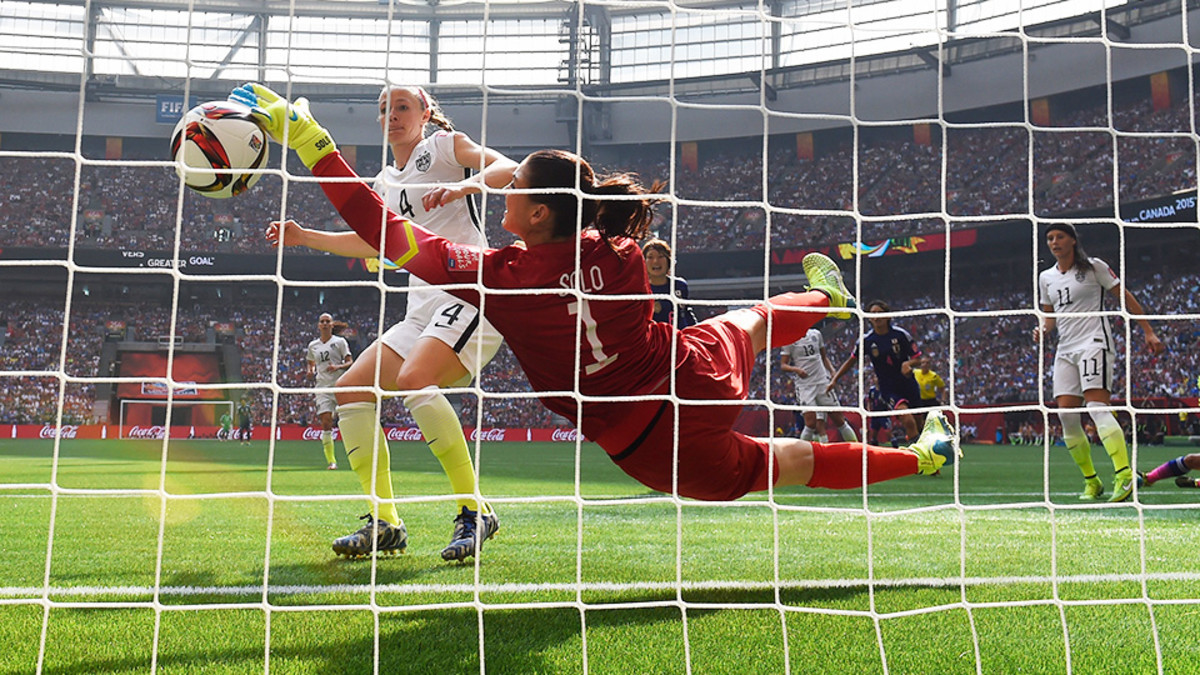Inside Hope Solo's innovative goalkeeper training and fitness
This story appears in the Feb. 29, 2016, issue of Sports Illustrated. Subscribe to the magazine here.
A diving save in soccer is a picture-perfect moment: a gymnastic display of quick reflexes, a gutsy leap with outstretched arms and unfurled fingers. For U.S. women’s national team goalkeeper Hope Solo, preparing for that instant begins not on a grassy surface but a reflective one.
“I put tape on a mirror, and I look and make sure that my head and chest are always still when I’m moving,” says the 34-year-old Solo. “You don’t want to be going up and down, because either you can’t see the ball or you’ll be too late. It’s about being steady and balanced.”
Since 2013, Solo has worked with Ben Dragavon, who doubles as the goalkeeper coach and the head strength- and-conditioning coach for Solo’s Seattle Reign FC of the National Women’s Soccer League. He’s also a certified specialist in Muscle Activation Technique (MAT), which seeks to optimize muscle contraction to provide stability and increase range of motion. Solo says the technique has helped her better control her center of gravity.
“You’re really mentally trying to learn your body from the inside out. It takes a lot of focus. You can’t really have people talking or a ton of music playing,” she says. “In the gym I work on movement that gets me to the ball faster. If my footwork is incredibly efficient in everything I do then I can get across the goal quickly to dive.”
Workouts vary based on Dragavon’s daily evaluations of Solo’s range of motion in her feet, hips, lower back, shoulders and spine. If he detects the slightest inefficiency in movement, he’ll change a drill or an exercise.
The SI Extra Newsletter Get the best of Sports Illustrated delivered right to your inbox
Subscribe
“She was having issues loading one leg more than another—when she was shuffling across the goal, her center of mass would shift over to one leg a little bit more than the other side and it affected her balance slightly,” Dragavon says. “As a goalkeeper, if a ball gets deflected she needs to be able to shift around and change direction on the fly. So it’s not good if her balance is all on one leg instead of split between two.”
Hope Solo reiterates concerns over Zika at the Olympics
Dragavon says MAT—a method founded by Greg Roskopf who has worked with Peyton Manning, the Denver Broncos and the Denver Nuggets—is a neuromuscular assessment of the muscles that allows him to identify a weak link and ultimately make an athlete more efficient. When working with Solo, sometimes finding that deficiency is a challenge.
“Hope's increments of improvement are so small. A lot times I have to film things and look at it in slow motion and see if I can see a hitch in her movement pattern,” Dragavon says. “But when I see something that doesn’t quite lineup, we’ll go through tests and exercises get [the muscles] to fire better and we’ll generally see improvements within a session really quickly.”
Solo says she now understands how to use other muscle groups in the body—instead of pure power—to raise her arms higher and complete other movements. In addition to utilizing the mirror, Solo also concentrates on specific aspects of her footwork.
“I don’t pick up the leg, I just graze the floor and then I can get across the goal quickly for diving,” she says. “As soon as you start doing footwork where you start picking up your feet, you can’t get your weight over your feet to dive. Or if you’re standing up straight, you can’t get your shoulder down to dive.
“Just doing all of that footwork it strengthens my calves and my quads and I don’t have to lift weights too much. I can do everything I need to do inside the gym to take a break for my shoulder.”
Workouts in the gym can also include reverse box jumps—starting on top of the box and jumping down to work on staying level and moving without dipping—circuit training and footwork drills using rubber rings or resistance bands, in order to maintain an equal distance between the feet.
To help with the mental side of the game and the unique struggles as a netminder, Solo turns to her goalkeeper coach, family members and Carli Lloyd’s trainer, James Galanis, whom she met in 2005.
“He’s been a huge part of helping me overcome challenges, on and off the field,” Solo says of Galanis. “He’s a huge philosopher in my life.”
When she’s with the U.S. national team, Solo does the same fitness training as the team’s field players—including the beep test and other vertical, lateral speed and agility tests—and does technical keeper training before the rest of the team begins a practice session.
Though the national team coaches don’t incorporate MAT into Solo’s workouts, she says she’ll keep using it as she prepares for the Olympics in Rio this August.
“You have to find new ways to train and new ways to look at your game—that’s what keeps me wanting to continue to grow,” Solo says. “It’s a different sense when you’re able to walk into the stadium and smell the grass and feel the dew and slide and dive and not have it hurt. It just feels good.
“I think the feel of this tournament is going to be very different than the World Cup in Canada. And that excites me.”








